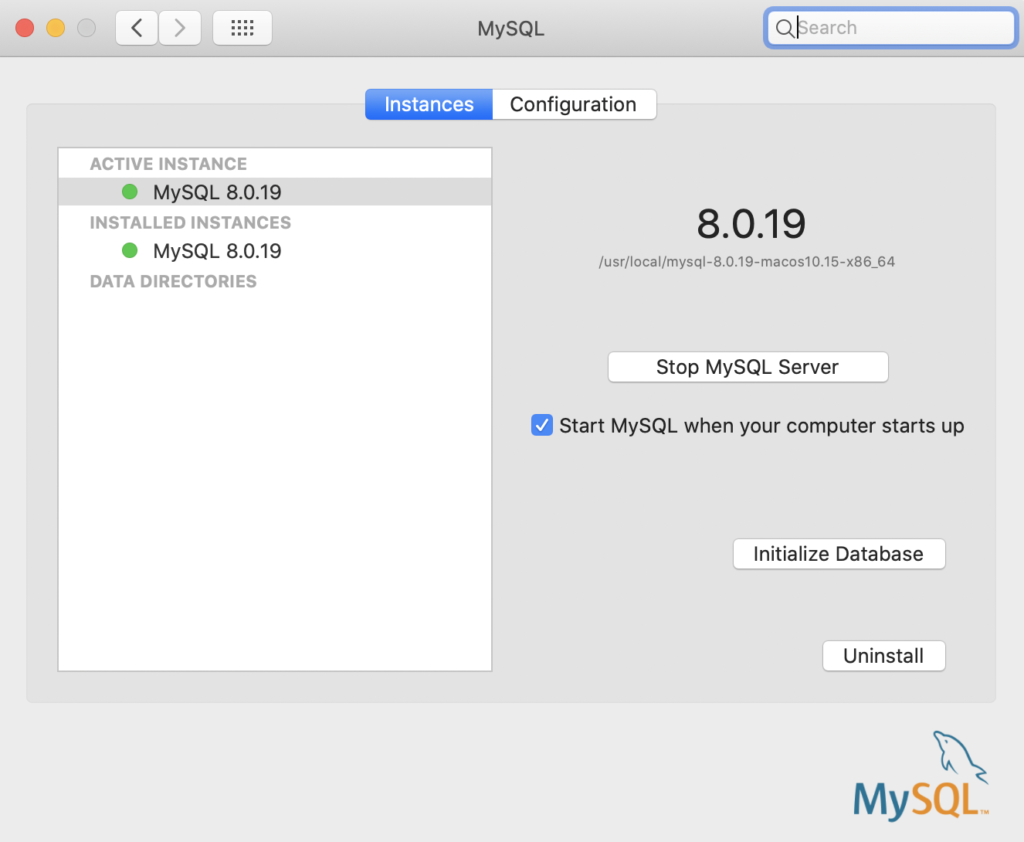Mysql Preference Pane Mac Download
- Mysql Preference Pane Mac
- Mac Mysql Preference Pane
- Mac Mysql Download
- Install Mysql Preference Pane Mac
How to Start My SQL on a Mac. The MySQL server is installed on the Mac, but it does not load by default. Start MySQL by clicking Start using the MySQL Preference Pane, which was installed during the default installation. You can configure MySQL to automatically start when you turn on your computer using the MySQL Preference Pane. You have some older preference panes that only work in 32-bit mode, so System Preferences must re-load in 32-bit mode to run those preference panes. Make sure that they have been updated for Yosemite. Yosemite will not autostart via a StartupItem. You can easily write a Launchd plist file to auto-start MySQL, but the nice MySQL preference pane that allows a user to turn MySQL off and on again would not function. There is a supporting script from MySQL that handles the start/stop/status functions for the preference pane.
2.4.2 Installing MySQL on macOS Using Native Packages
Mysql Preference Pane Mac
The package is located inside a disk image (.dmg) file that you first need to mount by double-clicking its icon in the Finder. It should then mount the image and display its contents.
Before proceeding with the installation, be sure to stop all running MySQL server instances by using either the MySQL Manager Application (on macOS Server), the preference pane, or mysqladmin shutdown on the command line.
To install MySQL using the package installer:
Download the disk image (
.dmg) file (the community version is available here) that contains the MySQL package installer. Double-click the file to mount the disk image and see its contents.Double-click the MySQL installer package from the disk. It is named according to the version of MySQL you have downloaded. For example, for MySQL server 8.0.24 it might be named
mysql-8.0.24-osx-.10.13-x86_64.pkgThe initial wizard introduction screen references the MySQL server version to install. Click to begin the installation.
The MySQL community edition shows a copy of the relevant GNU General Public License. Click and then to continue.
From the Installation Type page you can either click to execute the installation wizard using all defaults, click to alter which components to install (MySQL server, MySQL Test, Preference Pane, Launchd Support -- all but MySQL Test are enabled by default).
Although the option is visible, the installation location cannot be changed.
Figure 2.14 MySQL Package Installer Wizard: Installation Type
Figure 2.15 MySQL Package Installer Wizard: Customize
Click to install MySQL Server. The installation process ends here if upgrading a current MySQL Server installation, otherwise follow the wizard's additional configuration steps for your new MySQL Server installation.
After a successful new MySQL Server installation, complete the configuration steps by choosing the default encryption type for passwords, define the root password, and also enable (or disable) MySQL server at startup.
The default MySQL 8.0 password mechanism is
caching_sha2_password(Strong), and this step allows you to change it tomysql_native_password(Legacy).Figure 2.16 MySQL Package Installer Wizard: Choose a Password Encryption Type
Choosing the legacy password mechanism alters the generated launchd file to set
--default_authentication_plugin=mysql_native_passwordunderProgramArguments. Choosing strong password encryption does not set--default_authentication_pluginbecause the default MySQL Server value is used, which iscaching_sha2_password.Define a password for the root user, and also toggle whether MySQL Server should start after the configuration step is complete.
Figure 2.17 MySQL Package Installer Wizard: Define Root Password
Summary is the final step and references a successful and complete MySQL Server installation. the wizard.
Figure 2.18 MySQL Package Installer Wizard: Summary
MySQL server is now installed. If you chose to not start MySQL, then use either launchctl from the command line or start MySQL by clicking 'Start' using the MySQL preference pane. For additional information, see Section 2.4.3, “Installing and Using the MySQL Launch Daemon”, and Section 2.4.4, “Installing and Using the MySQL Preference Pane”. Use the MySQL Preference Pane or launchd to configure MySQL to automatically start at bootup.

When installing using the package installer, the files are installed into a directory within /usr/local matching the name of the installation version and platform. For example, the installer file mysql-8.0.24- installs MySQL into osx10.15-x86_64.dmg/usr/local/mysql-8.0.24-osx10.15-x86_64/ with a symlink to /usr/local/mysql. The following table shows the layout of this MySQL installation directory.
The macOS installation process does not create nor install a sample my.cnf MySQL configuration file.
Table 2.7 MySQL Installation Layout on macOS
| Directory | Contents of Directory |
|---|---|
bin | mysqld server, client and utility programs |
data | Log files, databases, where /usr/local/mysql/data/mysqld.local.err is the default error log |
docs | Helper documents, like the Release Notes and build information |
include | Include (header) files |
lib | Libraries |
man | Unix manual pages |
mysql-test | MySQL test suite ('MySQL Test' is disabled by default during the installation process when using the installer package (DMG)) |
share | Miscellaneous support files, including error messages, dictionary.txt, and rewriter SQL |
support-files | Support scripts, such as mysqld_multi.server, mysql.server, and mysql-log-rotate. |
/tmp/mysql.sock | Location of the MySQL Unix socket |
2.4.2 Installing MySQL on macOS Using Native Packages
The package is located inside a disk image (.dmg) file that you first need to mount by double-clicking its icon in the Finder. It should then mount the image and display its contents.


Before proceeding with the installation, be sure to stop all running MySQL server instances by using either the MySQL Manager Application (on macOS Server), the preference pane, or mysqladmin shutdown on the command line.
To install MySQL using the package installer:
Download the disk image (
.dmg) file (the community version is available here) that contains the MySQL package installer. Double-click the file to mount the disk image and see its contents.Figure 2.14 MySQL Package Installer: DMG Contents
Double-click the MySQL installer package from the disk. It is named according to the version of MySQL you have downloaded. For example, for MySQL server 5.7.33 it might be named
mysql-5.7.33-osx-.10.13-x86_64.pkgThe initial wizard introduction screen references the MySQL server version to install. Click to begin the installation.
Figure 2.15 MySQL Package Installer Wizard: Introduction
The MySQL community edition shows a copy of the relevant GNU General Public License. Click and then to continue.
From the Installation Type page you can either click to execute the installation wizard using all defaults, click to alter which components to install (MySQL server, Preference Pane, Launchd Support -- all enabled by default).
Although the option is visible, the installation location cannot be changed.
Figure 2.16 MySQL Package Installer Wizard: Installation Type
Figure 2.17 MySQL Package Installer Wizard: Customize
Click to begin the installation process.
After a successful installation, the installer displays a window with your temporary root password. This cannot be recovered so you must save this password for the initial login to MySQL. For example:
Figure 2.18 MySQL Package Installer Wizard: Temporary Root Password
MySQL expires this temporary root password after the initial login and requires you to create a new password.
Summary is the final step and references a successful and complete MySQL Server installation. the wizard.
Figure 2.19 MySQL Package Installer Wizard: Summary
MySQL server is now installed, but it is not loaded (or started) by default. Use either launchctl from the command line, or start MySQL by clicking 'Start' using the MySQL preference pane. For additional information, see Section 2.4.3, “Installing a MySQL Launch Daemon”, and Section 2.4.4, “Installing and Using the MySQL Preference Pane”. Use the MySQL Preference Pane or launchd to configure MySQL to automatically start at bootup.
When installing using the package installer, the files are installed into a directory within /usr/local matching the name of the installation version and platform. For example, the installer file mysql-5.7.33- installs MySQL into osx10.13-x86_64.dmg/usr/local/mysql-5.7.33-osx10.13-x86_64/ . The following table shows the layout of the installation directory.
Table 2.7 MySQL Installation Layout on macOS
Mac Mysql Preference Pane
| Directory | Contents of Directory |
|---|---|
bin | mysqld server, client and utility programs |
data | Log files, databases |
docs | Helper documents, like the Release Notes and build information |
include | Include (header) files |
lib | Libraries |
man | Unix manual pages |
mysql-test | MySQL test suite |
share | Miscellaneous support files, including error messages, sample configuration files, SQL for database installation |
support-files | Scripts and sample configuration files |
/tmp/mysql.sock | Location of the MySQL Unix socket |

Mac Mysql Download
Install Mysql Preference Pane Mac
During the package installer process, a symbolic link from /usr/local/mysql to the version/platform specific directory created during installation is created automatically.
